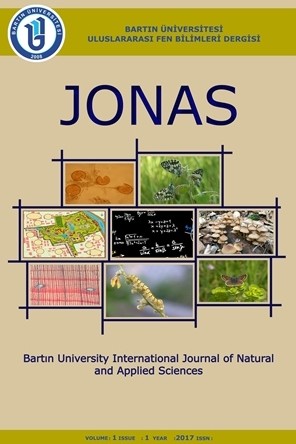SOME PHYSICAL PROPERTIES OF THE BUILDING STONES FROM SOUTHEASTERN ANATOLIA REGION
Andezit tüf, building stones, building materials
SOME PHYSICAL PROPERTIES OF THE BUILDING STONES FROM SOUTHEASTERN ANATOLIA REGION
Andesite tuff building stones, building materials, physical materials,
___
- 1. Devecioglu A.G. (2001), An investigation on the heat conduction parameters of porous building stones, Master Thesis, Firat University.
- 2. Devecioglu A.G., Biçer Y. & Kavak E. (2001), Diyarbakır Karacadağ taşının bazı fiziksel özellikleri, II. GAP ve SANAYİ Kongresi, 29-30 Eylül, TMMOB Makina Mühendisleri Odası, 401-406, Diyarbakir.
- 3. Bicer Y., Yildiz C. & Pehlivan D. (1996), Some physical properties of the building stones from Mardin and Its Districts, TIEES-96 First Trabzon International Energy and Environment Symposium, July 29-31, Vol. 3, 1005-1009, July 29-31, Trabzon-Turkey.
- 4. Bicer Y., Tanyildizi V., Pehlivan D. & Yildirim, S. (1993), A research on the physical features of the natural building materials available in Firat Basin, Cukurova University Journal of Faculty of Engineering and Architecture, Vol 8 (2), 53-60.
- 5. Biçer Y., Devecioglu A.G &Akpinar E.K. (2004), Effective thermal conductivity of porous stones, Firat University Turkish Journal of Science & Technology, 15(4), 613-622. 6. TS 500 and TS 699, (2000), The test and experiment methods of natural building stones, TSE, Ankara.
- 7. Bicer A. & Kar F. (2017), The effects of apricot resin addition to the light weight concrete with expanded polystyrene, Journal of Adhesion Science and technology, 31(21), 2335-2348.
- 8. Kaya A, & Kar F. (2017), Thermal and mechanical properties of gypsum plaster mixed with expanded polystyrene and tragacanth, Thermal Science and Engineering Progress, 1, 59-65.
- 9. Kaya A & Kar F. (2016), Properties of concrete containing waste expanded polystyrene and natural resin”, Construction and Building Materials, 105: 572-578.
- 10. Toksoy M. (1988) Thermal conductivity coefficients of industrial materials, Journal of Engineers and Machinery, 347, 12-15.
- Yayın Aralığı: Yılda 2 Sayı
- Başlangıç: 2017
- Yayıncı: Bartın Üniversitesi
THE FACTORS THAT THREATEN THE MIGRATORY BIRDS
AN OPTIMIZED COMET ASSAY PROTOCOL FOR DROSOPHILA MELANOGASTER
HYDROGEN AS AN ENERGY CARRIER AND HYDROGEN PRODUCTION METHODS
Halil MUTLUBAŞ, Zafer Ömer ÖZDEMİR
SOME PHYSICAL PROPERTIES OF THE BUILDING STONES FROM SOUTHEASTERN ANATOLIA REGION
ENERGY AND EXERGY ANALYSIS OF A NOVEL THREE-STAGE HEAT PUMP DRYING SYSTEM
PROFIT ENHANCEMENT OF MEAT PRODUCTS MARKETING : THE CASE OF FAST FOOD AGRIBUSINESS IN NIGERIA
Felix ACHOJA, Daniel Chukwujioke OKEKE, İfeyinwa Alexandra EGBUIWE
CHANGES OF PHENOLIC COMPOUNDS IN TOMATO ASSOCIATED WITH THE HEAVY METAL STRESS
Dursun KISA, Ömer KAYIR, Necdettin SAĞLAM, Sezer ŞAHİN, Lokman ÖZTÜRK, Mahfuz ELMASTAŞ
AKSEKİ SARIHACILAR KÖYÜ CAMİ AHŞAP TEŞHİSİ
Barbaros YAMAN, Ali Akın AKYOL, Kısmet AKTAŞ
FIRAT HAVZASINDA BULUNAN BAZI İLLERİN SICAKLIK VE NEM MODELLERİ
